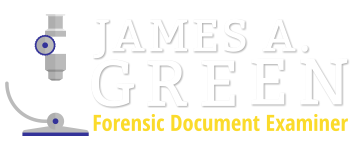Forensic Document Examiners are retained for their expertise in many areas. However, signature comparisons are requested more often than other types of analysis. As you can imagine, signature forgeries are very common, causing tremendous financial losses.
What is Signature Forgery?
There are many circumstances in which a person may sign another person’s name. Having an authorized Power of Attorney to sign on behalf of a person experiencing age-related physical or mental issues, is one example. However, signature forgery becomes a crime when a person signs another person’s name with the intent to defraud.
Signature fraud is committed by petty criminals to white-collar professionals. Generally, a forgery conviction may be prosecuted as a felony if the loss exceeds a certain dollar amount.
Common Ways Signatures May Be Forged
Those who attempt to commit signature forgery often do so by one of three common methods.
1. Blind or Random Forgery
This is the simplest and often the most easily identifiable signature fraud. The forger simply writes another person’s name, with no basis or concern for what the other person’s signature looks like. This is common in check fraud, where a thief has stolen checks from a mailbox and does not have a genuine signature of the account holder to use as a “model,” when signing the checks.
2. Tracing
Tracing a signature requires that the person attempting to replicate the signature has a copy of the victim’s authentic signature. They will then trace the signature onto the document they are attempting to fabricate.
3. Simulating/Replicating
This type of forgery also requires an authentic signature for the forger to mimic. The forger may practice simulating the true signature prior to signing the document at issue. A free-hand simulation of a signature is the most common type of forgery.
Indications of a Forged Signature
The legal system commonly relies upon an experienced, professional Forensic Document Examiner to confirm a forgery. There are features a document examiner, and you, may look for when evaluating a signature suspected of being forged.
• Abrupt Starts and Stops
When someone is trying to forge a signature, they may reposition the pen as they stop to review the model signature. Also, they may begin and end the signature without the natural fluency of normal writing. Signatures are commonly made with the pen moving as it comes into contact with the document as well as moving up and away when the signature is completed.
• Hesitation or Pen Lifts
Subtle gaps or overlapping of ink lines may indicate unnatural writing, raising suspicion about a signature. Occasionally, the forger will leave hesitation points along the signature ink strokes as they leave the pen in contact with the paper when they refer to the genuine signature. The capillary action of the paper fibers may draw ink from the pen, causing ink dots or periods on the stroke path.
• Consistent Thickness
Authentic signatures generally include tapering lines, as the pen flows quickly and naturally across the paper. As writers, we commonly impart more pen pressure on the down strokes and less on the upstrokes. With more pen pressure, the strokes appear wider in contrast to the thinner strokes made with upward pen movements.
Documents That Are Susceptible to Signature Fraud
Virtually any document can include a forged signature, but valuable documents are especially vulnerable to fraud. They include:
- Checks
- Court Documents
- Deeds
- Contracts
- Prescriptions
- Stock Certificates
- Titles
- Wills
- Election documents
Signature analysis and comparison performed by an experienced Forensic Document Examiner can help you establish if a signature is genuine or not.
Get Help with Suspected Forged Documents
If you believe a document pertaining to a court case, workplace or person issue involves a forged signature, contact a professional Forensic Document Examiner. James A. Green was trained at the Eugene OR Police Department and has 33 years of experience. To discuss your case, call 888-485-0832 or send a message today.

